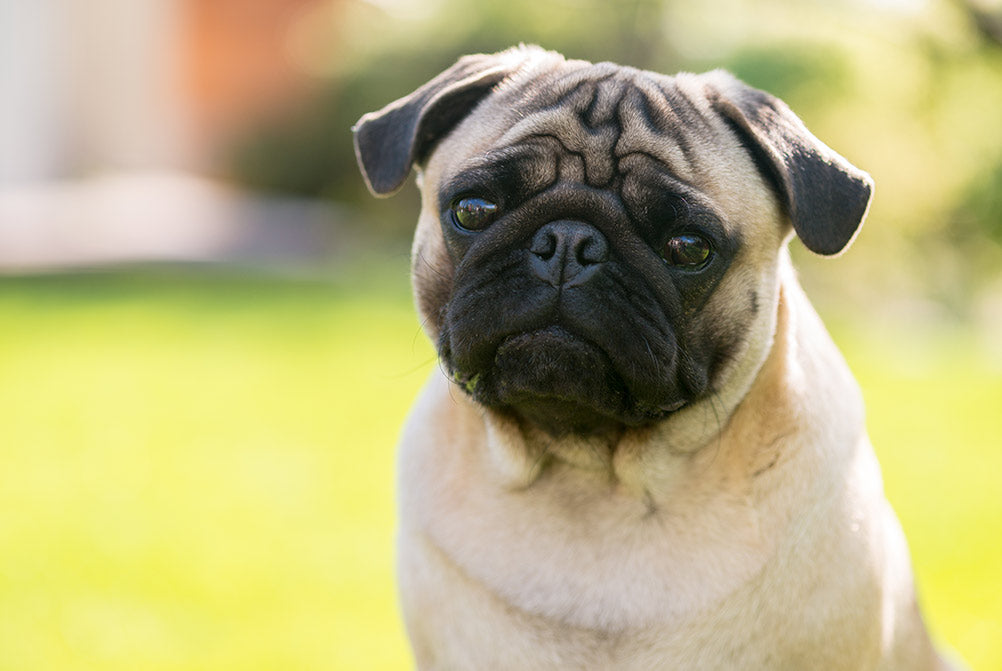
The Gassy Dog: How to Reduce Those Foul Emissions
Dog flatulence is a funny topic. We are, after all, talking about farts, which smell funny and sound funny. But if you’ve ever had to address that elephant in the room that is your gas-prone pup, especially during the holidays when guests and family are visiting, the humor is harder to appreciate. The stress that your gassy dog can have on your relationship together is no laughing matter.
In this article, we are going to discuss first the reasons why dogs experience excessive gas and following that we’ll have several tips to help you stop and prevent those foul fumes.
The Facts of Flatulence
There are two main categories when discussing causes of excessive gas. The first, and most common is related to diet. The second revolves around ingestion of air. We’ll start with diet and digestive causes first.

Those Bloat-Causing Bacteria
We all have bacteria that live inside our digestive tract that contribute to our bodies’ normal digestive processes. But under the right conditions and with the right nutrients, bacteria in the colon can produce gas. Now most of the time, this gas is not all that smelly. But in certain cases, a break-down product is hydrogen sulfide gas, which is that disturbing malodorous smell we’ve all come to dread.
These bacteria are made up of different populations that exist in a kind of delicate balance. Throwing off the balance can lead to a disruption of these populations with certain populations of gas-producing bacteria predominating.
But what is it that encourages these bacteria to produce gas? Well, if you take a simple sugar, like glucose, and put several such sugar molecules together, you get a slightly more complicated molecule called an oligosaccharide. Oligosaccharides cannot be digested and have to be broken down further first. But dogs and cats lack the enzymes necessary to digest many of them. Thus, our bacteria friends in the colon break them down eventually, and the byproduct of this is gas.
Avoiding foods high in oligosaccharides can help avoid the toots. These foods include legumes like peas, beans, and soybeans. This is why beans have that stereotypical bad reputation.
Certain types of fiber, called fermentable fiber, can also slow down intestinal contents and allow bacteria to break down nutrients, the process for which is called fermentation. The byproduct of this is also gas.
Air is for Breathing, Not Swallowing
But tell that to a super athletic dog, a pup who wolfs his food down so fast that an equal amount of air goes with it, or a French Bulldog whose squishy face is indeed very cute but not developed well for breathing normally.
This is our second category, which is ingestion of air. Now fortunately, while gulping air does lead to excessive gas, most of the time this gas is not malodorous unless there is also a digestive issue as we covered above.
Balanced Exercise
While regular exercise is a good thing, and going for a 30 minute walk right after eating might even help alleviate gas problems (at least in your house), regular intense exercise that leads to increased gulping of air can lead to more gas. This is reported more in sporting and eventing dogs that are competing at high levels.
If you have two pooches that compete for food, you might see increased flatulence because of their eating behavior. If a dog is concerned that her food might be eaten by another, she may gulp down that food, and a lot of excess air with it.
I enjoy seeing Pugs, Bulldogs, and French Bulldogs. They often have great dispositions and are really cute. But these breeds with short faces and that cute, snuffly snort with every breath are also known to be big gas passers. Thus, it’s a rare appointment I’ll have with one of these little guys without getting a whiff of something. Most of the time, my client and I both know it was the dog.
Genetic Factors
Brachycephalic syndrome describes certain physical features of these pups including narrowed nasal passages, everted laryngeal saccules, and an elongated soft palate. These physical features, while pups are born with them and while they do give brachycephalics that endearing personality, contribute to difficulty taking in air. Since they can’t breathe well through their noses or windpipe, these pooches suck in air as often as they can, which leads to a lot of air swallowing, termed aerophagia. This air moves along through until it eventually leaves as that odiferous whiff.
If you have one of these cute little guys, then gas may unfortunately be something to get used to but there is an alternative to mention for these breeds. There is a combination of surgeries that can be performed to open up the airways for brachycephalic pups which allows them to breathe better. This involves trimming the extremely long soft palate short, removing the laryngeal saccules that poke out into the airway, and widening the outer opening to the nasal passages. These procedures are worth discussing with your veterinarian, especially if your Pug or Bulldog is an especially loud breather, snorer, has a hard time tolerating exercise, or as we’ve discussed, has a lot of gas from all that air gulping.
Tips to Boot the Toots
Now that we’ve gone over the science and the whys of flatulence, let’s get in to how we can both stop a gassy dog from clearing out the living room as well as how to continue to prevent those noxious gasses.
Careful Use of Carminatives
Car-what? Carminatives are medicines that help to reduce flatulence. This would include the human medicines simethicone (Gas-X), Alpha-galactosidase (Beano), and bismuth subsalicylate (Pepto Bismol). I included this category first, because it might be a common line of thought to just pop your pup a Gas-X if he seems extra gassy, right? Well, unfortunately, you may have limited success with some of these products and veterinarians don’t recommend them for the most part.
Concerns with Carminatives
Gas-X might be helpful, and it’s not harmful, but it doesn’t have the same efficacy in pets as it does in people, and it will not help with any foul odors. Beano is a product to avoid simply because it contains enzymes only useful for human digestion. While one or two small doses of Pepto may be okay, avoid further use without consulting with your vet. The salicylates in Pepto could cause stomach bleeding in some dogs, and the bismuth can make stools look black, which could also be mistaken for blood in the digestive tract. It can also be contraindicated with some medications your dog could be on, like the anti-inflammatory carprofen and is probably best avoided. As a special note, Pepto is considered outright toxic to our feline companions, and should never be given to a cat.
Probiotics can be helpful from the perspective of helping to rebalance the bacterial populations, especially if gas-producing bacteria are dominating the field. Thus in theory, you can reduce gas by reducing the proportion of gassy bacteria. This may be better in theory than reality, but probiotics can be helpful in other ways too, including other digestive issues.
Contrary to some of our predecessors, the yucca plant has actually shown to reduce the foul sulfurous odor for dog toots, and is found in many canine gas aids, including No Toot, which also has more dog-appropriate digestive enzymes and probiotics to aid digestion.
Feed a Highly Digestible Diet
Because excessive gas can have many causes, one of the best places to start is with a highly digestible diet. Highly digestible nutrients reduce food residues and provide less substrate for bacterial fermentation in the colon.
Many special gastrointestinal diets are formulated with this in mind. Rice, for example, is one of the most highly digestible carbohydrate sources and is found in many sensitive stomach formulas.
Another consideration for diet is to keep fiber, soluble fiber specifically, to less than 5%. As mentioned, certain types of fiber can slow down intestinal contents and allow bacteria more time for fermentation. Examples of soluble fiber sources to keep an eye out for include: soy, pea, psyllium, pectin, guar gum, carrageenan, bran, and beet pulp. If included in your pooch’s food, they should be found in the ingredients list on the packaging.
Many low residue formulas should already account for these fiber restrictions. It’s best to speak with your vet about what diet choice may be best for your pup.
Avoid Table Food
Table scraps can be a favorite treat for the family dog, but for many reasons, you should avoid this practice. After having our long discussion about how sensitive dogs’ digestive tracts can be to sudden changes, it should go without saying that changing it every day can lead to some gaseous indigestion.

Avoid Dairy
I love a cool glass of milk and one of my favorite snacks is a nice slice of gouda cheese (or five or six). But not everyone can enjoy dairy without side effects and dogs can be the same way. While many may not realize it, a large number of dogs (and cats surprisingly) are lactose intolerant. Ingesting dairy products, including milk, cheese, and yogurt, can lead to some pretty foul smells. Now a small amount, like for a treat once in a while, is likely not an issue and some yogurt can have good probiotic properties, but keep an eye out: bad tooting problems after feeding dairy could be the cause of your woes.
Don’t Make Sudden Diet Changes
Remember when we discussed those populations of gassy bacteria? When changing diets (to your new highly digestible diet!), you should always do so slowly over several days to allow these populations to readjust. I always recommend changing diets over about a 5-7 day period, to allow your pooch’s digestive system time to catch up.
Avoid Sulfur-Containing Vegetables
These include broccoli, cauliflower, brussels sprouts, and cabbage. While these veggies are otherwise healthy enough in modest amounts, they do contribute to that noxious sulfurous smell associated with those gassy toots.
Avoid Fruit
Fruits and high-fructose corn syrup can be indigestible for your pooch. Fruits can have a high amount of soluble fiber, which as we discussed earlier can lead to excessive gas from bacterial fermentation.
Avoid Legumes (Peas, Beans, etc.)
Legumes like peas, beans, and soybeans contain those pesky oligosaccharides we talked about, which can’t be digested and are only broken down by those gas producing bacteria in the colon.
Avoid Onions, Nuts, and Spices
If you’ve read our article on foods that are bad for dogs, you already know to avoid onions (and garlic). But the reason these can contribute to gas, is that they contain odiferous sulfur compounds which when broken down can lead to hydrogen sulfide gas production.
Nuts and spices can contribute to excessive gas production. Just like people, dogs may not tolerate certain spices, especially onion powder and garlic salt!
Feed Smaller Meals More Often
This depends on your schedule of course, but if you are able to split your pup’s diet into smaller portions and feed them more often throughout the day, not only will her metabolism thank you, but she’ll also be less prone to gulping air in conjunction with a single large meal.
Slow Down Feeding
If your pup is the kind to wolf down his food, there are several methods of changing his food bowl to slow down his eating, and hopefully by extension, reduce his air consumption. There are many commercial puzzle bowls available in different designs that you can purchase. A simple home-made method is to take a small bowl, turn it upside down, and place it in the middle of your pooch’s larger food bowl. This way, he has to eat his food from around the edges, and there is no way for him to submerge his head into his kibble.
Reduce Food Competition
As discussed, if you have two or more pups, one may inhale his food to avoid it from being eaten by the other. Even if the other dog or dogs would never steal his food, some dogs already have this paranoid instinct. In the wild, it behooves any carnivore to get as much from his new kill as possible, since he doesn’t know who might come along to claim it. If your
gassy dog seems to have this instinct, feed your pups in separate, quiet places. With some consistency, your nervous pup will learn that she has nothing to fear about her food being eaten by another.
Take a Short Walk After Meals
This tip is more about diverting the gas odors to the outdoors vs. stopping them altogether, but it’s a start. While we did discuss how heavy, competitive exercise could lead to gas, taking your pup out for a 30 minute walk shortly after eating, can actually help. Everyone can have some gas build-up shortly after eating, so going for a walk or jog right after can help get it out in the outdoors and keep your indoors smelling fresh.

Here’s to Clean Air
You should be able to find some good starting points for helping your pup reduce those emissions. Make sure to speak with your veterinarian about some of these tips so that you’re both on the same page. Your vet can help guide you with diet choices and advise on adjustments to the plan depending on how your pup responds. Here’s to a happy and gas-free holiday season!
JOIN OUR PACK
Follow us @NaturVet on social media to fill us in on any tips we might have missed. And, check out the rest of NaturVet.com. We’ll keep you up to date on all our latest pet resources, supplements, tips and tricks, and more – everything you need to be the best pet parent possible.






